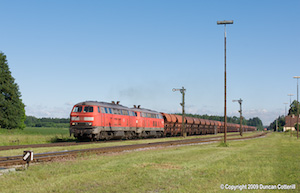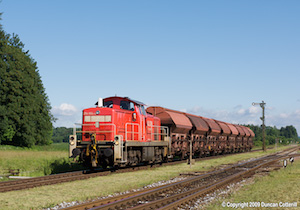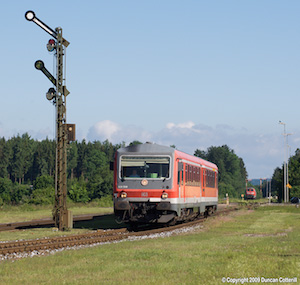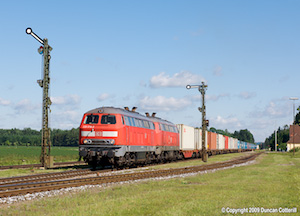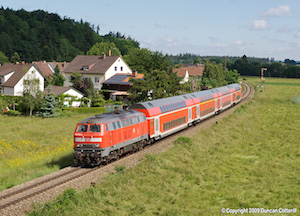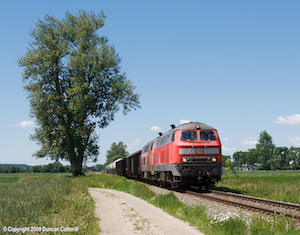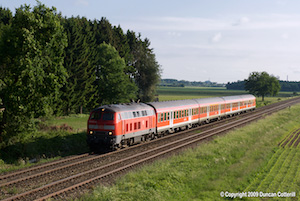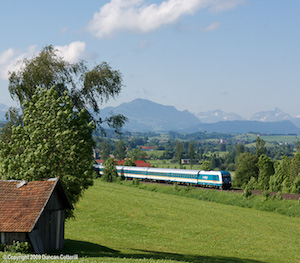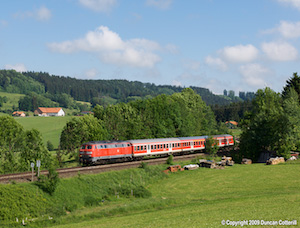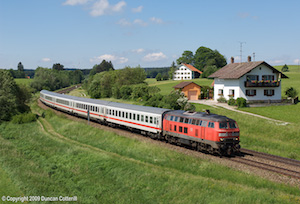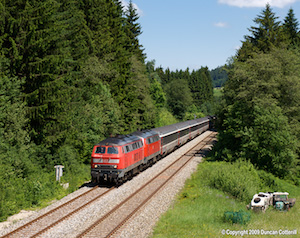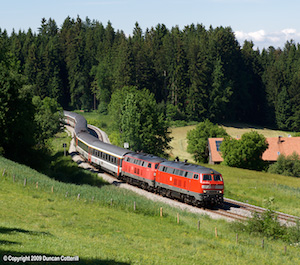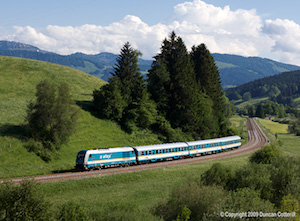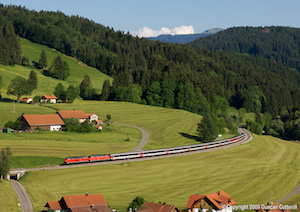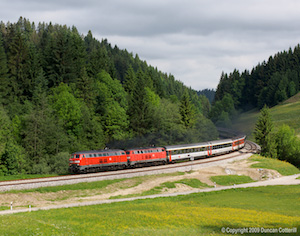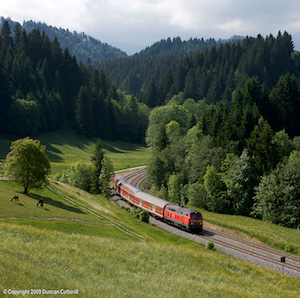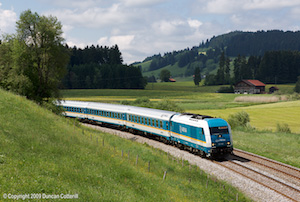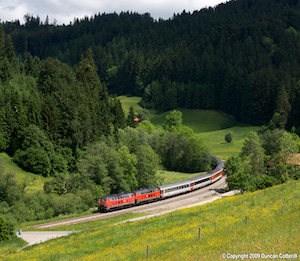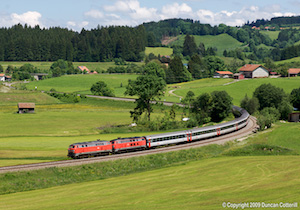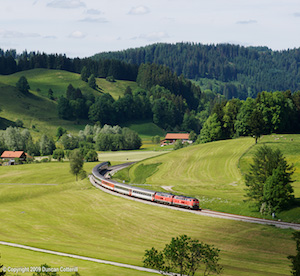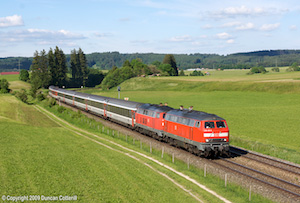Voyage to the Mühldorf Star
27 - 31 May 2009
Report by Duncan Cotterill
Introduction
The Mühldorf Star isn’t somewhere in the far reaches of the galaxy, it’s actually a radial network of diesel worked lines in the south-eastern corner of Germany. As well as having a number of loco hauled passenger trains, several different classes of diesel can be seen on freight and many stations still have semaphore signals. This report covers a three-day photographic trip to the Mühldorf area in late May followed by a couple of days on Germany's most photogenic main line, the Allgäubahn, photographing diverted diesel hauled EuroCity trains.
I hadn’t intended going back to Germany so soon after my last trip in late April and certainly didn’t expect to returning to the Allgäubahn but that was the way it turned out. Airfares to everywhere else I thought of going were just plain silly. Luckily, Aer Lingus still had reasonable prices from Gatwick to München and Mühldorf sounded worth a look. There was still the problem of what to do at the weekend when the area's freight traffic dries up. My initial thoughts were to hop across to Austria and do the electrified main line east of Salzburg on the Saturday before returning to the Freilassing – Traunstein section of the Salzburg – München main line in Germany on the Sunday. The discovery, a few days before departure, that the München – Zürich ECs were due to be diverted via Kempten over the weekend was an opportunity too good to miss and plans were quickly re-hashed.
The Mühldorf Star
Mühldorf lies on the River Inn some 80km east of München and is a busy railway junction with a locomotive depot and lines radiating in no less than eight different directions. Five lines leave from Mühldorf itself, heading west to München, north-west to Landshut, east to Simbach, south-east to Freilassing and south-west to Rosenheim. A further three lines branch off within 20km of Mühldorf, heading north-east to Passau, south to Traunstein and east to Burghausen. All lines are single track and unelectrified with semaphore signals still in use at the majority of stations. Apart from Burghausen, which is the terminus of a dead-end branch, and Simbach, which has a connection across the border to Braunau on the öBB, all the lines connect with electrified trunk routes at their far ends.
I had always imagined that the whole area was very flat but there's a lot of pleasantly rolling countryside, with a mixture of agricultural land and woodland, dotted with small farms and attractive towns and villages.
Passenger Services
Passenger services are operated by DB under the SüdostBayernBahn (SOB) banner. This SOB has nothing to do with the Swiss SOB (Südostbahn). The “o” is never capitalised when the name SüdostBayernBahn is written in full, so why not call it the SBB and avoid any confusion?
The line to München has a basic hourly service with a number of additional trains in the peak hours on weekdays. A high proportion of services are worked by Mühldorf based class 218 diesels on weekdays, Saturdays and on Sunday evenings. Many trains are operated by double-deck (dosto) push-pull sets with the loco at the Mühldorf end of the train but there are also trains of conventional hauled stock. A few trains are double headed or worked top ‘n’ tail and peak hour workings can have as many as ten coaches. There is also a daily Linz-München-Linz working, via Simbach and Mühldorf, hauled by an öBB class 2016 diesel. Class 628 DMUs work the remaining services, including most trains before 16:00 on Sundays.
In addition to the Linz-München and v.v. train, the Simbach line has a couple of through 218 hauled workings to/from München in the peaks on weekdays (RE27000, RE27001, RE27002, RE27003). There is a Mühldorf-Linz and v.v. working via Simbach but it's a class 628 DMU.
A 218 also works a Mühldorf - Landshut - Salzburg - Landshut - Mühldorf turn on weekdays with a dosto push-pull set (RB27204, RB27085, RB27086, RB27211). The loco leads away from Mühldorf on both the Landshut and Freilassing lines.
The most unusual working is a Saturday morning train to Passau (RE27005), worked by a class 218 on a short rake of InterCity stock. From Passau, the coaches are attached to a Hamburg service. There’s also a return working on Saturday evenings (RE27004), again 218 hauled.
Full details of the class 218 workings could be found on the www.v160.de website (no longer available). Everything else is worked by class 628 DMUs.
Services run hourly on the Simbach, Burghausen and Landshut lines and are basically two-hourly on the other lines. There are only two through trains each way on the Traunstein line, and they only run on weekdays. Other services terminate at Trostberg with no onward connection.
Every hour, trains converge on Mühldorf from many different directions between xx:20 and xx:30 and depart again between xx:30 and xx:40. In theory that makes for good connections but in practice I saw outgoing trains departing without waiting on a couple of occasions, even when the incoming train was only five minutes late.
Details of the loco hauled passengers seen can be found in the Day by Day section below.
Freight Traffic
The area south of Mühldorf is known as the "Chemie Dreieck" or Chemical Triangle on account of the large number of chemical plants located there.
The works at Gendorf and Wackerwerk, both located on the Burghausen branch, generate most of the area’s freight traffic with numerous trains of tanks, hoppers and containers running to and from Mühldorf on weekdays. Traffic to/from Gendorf is exchanged at Kastl (Gendorf station is just a single platform halt) and transfers into the works complex are handled by small industrial shunters. Trains to the chemical plants and refinery at Wackerwerk branch off a short distance before Burghausen station and continue a couple of km to exchange sidings adjacent to the works on the north side of town.
A few freights also run to Garching, on the Freilassing line, from where an industrial shunter transfers them to the plant at Harz an der Alz. From Mühldorf, most trains run west to München although there is some traffic on the Landshut line as well. There are also a few trains on Saturday mornings but nothing on Saturday afternoons or Sundays.
In addition to trains serving the chemical industry, there are also several trains of domestic refuse on weekdays from transfer stations around the region to what appears to be an incinerator at Gendorf.
Most freights are operated by DB Cargo / Railion / DB Shenker / K.Bay.Sts.B. Logistics (or whatever this week’s name for the freight arm of DB is) using locos of classes 217, 225, 233 and 294. The 217s are similar to class 216 but were built with with electric train heating that is now either out of use or removed. Although they are still very active, the 217s are over 40 years old and apparently on their way out. The 225s include former class 215s and also class 225.8, which were formerly class 218s. Interestingly, some 225.8s had been repainted with their full UIC numbers on the side, identifying them as 218s!
The diagrams are very complex with some trains being worked by different classes on different diagrams every day. In theory, most trains are booked for pairs of 217s, pairs of 225s or single 233s with the 294s handling the lightest duties but in practice mixed pairs of 217s and 225s were fairly common and trains often turned up with different power to that booked. Most trains identified from the class 217, 225 and 233 diagrams on www.v160.de actually ran, although a few were just light engines, and there were a few unexpected freights as well. Most trains were close enough to right time to be identifiable. There should also be occasional trains worked by locos of independent operators but I didn’t see any.
Freight locos seen (all in use)
- 217 002/012/017/018
- 225 002/008/010/071/079/084/094/803/805/809
- 233 233/486/596
- 294 606/822/864
EC Diversions in the Allgäu
Normal operations on the Allgäubahn have been covered in my previous reports from 2006, 2007, 2008 and April this year, so I won’t go into too much detail here, except to mention the differences from April.
Three of the four daily pairs of München – Zürich EuroCity trains normally run from Buchloe to Lindau via Memmingen, a faster but considerably less scenic route than the traditional Allgäubahn main line via Kempten. With the line closed west of Memmingen for engineering work on the last two weekends in May, all four pairs of ECs ran via the Allgäubahn, producing lots of photo opportunities not normally available.
Another welcome change since my last visit was the operation of a pair of additional trains on Saturdays and Sundays aimed at cyclists. The Radlzüge run from München to Lindau on Saturday and Sunday mornings and return north in the evenings. The trains are formed of a class 218 worked push-pull set with the loco at the Lindau end (a change from last year when it was at the München end). Although 218 hauled regional services were common on the line a few years ago, they are now extremely rare west of Immenstadt.
Day by Day
Wednesday 27 May 2009
An incredibly early start got me to Gatwick in good time for the departure of Aer Lingus flight EI930 to München at 06:40. The airport was full of Manchester United fans, quaffing ale at five in the morning like it was going out of fashion, while they waited for their flights to Rome and ignominious defeat at the hands of Barcelona. Don't suppose they were so upbeat on the way back.
Fortunately, I wasn't going their way. I hadn’t flown with Aer Lingus before so it was a relief to find that they were more like EasyJet with allocated seats than the other Irish lot. You still have to pay extra for everything from booking a ticket to choosing a seat in advance, checking in a bag or using the on-board toilets (I lied about one of them but I'm not saying which). While waiting at the gate, I was also impressed to see the co-pilot out on the tarmac counting the important bits like engines and wings to make sure we had enough and that they were evenly distributed on both sides of the plane. He even checked that the fan blades rotated freely on both engines, presumably just in case someone from a rival airline had superglued them in place during the night.
The flight itself was uneventful and the formalities quick and painless. Around half an hour after landing I was driving out of the airport towards Mühldorf in a garish yellow Fiat 500 (A fun car to drive but you had to make sure it was parked well out of the shot). Although the weather was reasonably good with broken cloud and long sunny spells, I failed to find any good locations on the line between Markt Schwaben and Mühldorf. The afternoon was spent on the Burghausen branch where several reasonable positions were found. The freights ran very much as expected but the sun was uncooperative, only coming out occasionally and never when there was a freight about.
The night was spent at the Gasthof Wimmer-Weissbräu, close to the station in Simbach. A bit out of the way perhaps but at €40 a night, much better value than the posh hotels in Burghausen or Mühldorf and still within 30 minutes drive of Tüssling or Kastl. It’s a comfortable, friendly, family run place with a singing granny providing the evening's entertainment. Just what you need after a hard day’s photography. You might even enjoy a drink with an öBB traincrew from Linz on a lodging turn.
Thursday 28 May 2009
The day dawned dull and grey. By the time I’d driven to Tüssling, junction of the Burghausen branch, there was no sign of the cloud breaking so I decided to do some exploring by train using a Bayern Ticket Single, excellent value at €20. I later found out that there’s a SüdostBayern Ticket covering just the SOB area, which was even better value at just €13.
My travels took me to Mühldorf (628), then to Salzburg via Freilassing on RB27085 (218465 hauling dostos), returning on RB27086 (218465 pushing dostos). The burgers of Salzburg appear to have lost the plot, building a perfect replica of the Berlin Wall along both sides of the railway all the way into the Hbf – what’s the sense in desecrating a beautiful city just to attenuate a bit of train noise when nothing is done about the incessant and all-pervasive drone of road traffic?
Back at Mühldorf the sky still wasn’t clearing, so it was off to Burghausen and back (628) and then to Markt Schwaben on RB27056 (218465 again, pushing dostos). By this time, there were a few breaks appearing in the cloud but they never really developed. I returned to Mühldorf on RE27003 (hauled by 218418 on Silberlingen) before travelling to Landshut and back (628) and finally returning to Tüssling (628) to pick up the car and drive back to Simbach for the night.
The day produced no photos but was very useful for identifying potential photspots for future use.
| Loco | Train | Details |
|---|---|---|
| 218418 | RB27031 | 08:17 München - Mühldorf |
| 218465 | RB27085 | 08:38 Landshut - Salzburg |
| 218465 | RB27086 | 11:10 Salzburg - Landshut |
| 218465 | RB27056 | 14:28 Mühldorf - München |
| 218418 | RE27003 | 15:07 München - Simbach |
| 218 444 + 218419 | RB27058 | 15:39 Mühldorf - München |
| 218465 | RB27070 | 18:30 Mühldorf - München |
| 218419 | RE27001 | 17:27 München - Simbach |
Friday 29 May 2009
Sunshine at last. First stop was Tüssling where a couple of unexpected freights were photographed in addition to the regular trains. A pair of class 225s went south to Garching on a long train of hoppers, followed by a class 294 hauling a few more hoppers. They were followed by the regular container train to Wackerwerk, hauled by another pair of 225s. Another two freights on the Burghausen line were missed while getting a shot of 218463 on RB27085 to Salzburg just south of the junction. Then things quietened down on the freight side until lunchtime. Around 13:00, a mass of dark cloud swept in from the north-east, followed by heavy thunder showers.
There were a few short sunny intervals around Tüssling during the afternoon but only one coincided with a freight train. Further south and east, the clouds didn’t break at all. By 18:00, it was obvious that the weather wasn’t going to clear up, so I set off for the Allgäu, hoping that the weekend traffic would have cleared by the time I reached München. Fortunately, it had and I managed a pleasant run through to my overnight stop at the Lechpark hotel in Untermeitingen, near Kaufering.
| Loco | Train | Details |
|---|---|---|
| 218463 | RB27085 | 08:38 Landshut - Salzburg |
Saturday 30 May 2009
I spent the morning working my way down to the Oberstaufen area via Lindenberg, Ellenberg, Görwangs and Riedles, all between Buchloe and Kempten, intercepting the diverted ECs and other loco hauled trains on the way. DB hadn’t bothered to retime the ECs specially for the weekend, they just ran up to half an hour late due to the slower journey over the Allgäubahn. There was a fair amount of cloud around during the morning but some good sunny breaks as well. By mid afternoon, the sky was clearing nicely and a number of good shots were taken between Oberstaufen and Röthenbach before the sun finally dropped below the horizon around 21:00.
I stayed the night at Steinhausers Hotel Gross in Oberstaufen.
| Loco | Train | Details |
|---|---|---|
| 218472 | RE32622 | 07:08 Augsburg - Füssen |
| 218416 + 218422 | EC196 | 07:12 München - Zürich |
| 223070 | ALX38705 | 07:47 Lindau - München |
| 218141 | RB32690 | 08:03 München - Lindau |
| 223068 | ALX38704 | 09:19 München - Lindau |
| 218419 + 218444 | EC191 | 07:16 Zürich - München |
| 218494 | IC2084 | 09:31 Oberstdorf - Augsburg |
| 223063 | ALX38707 | 09:59 Lindau - München |
| 218422 + 218 416 | EC193 | 09:16 Zürich - München |
| 223070 | ALX38706 | 11:19 München - Lindau |
| 223068 | ALX38711 | 13:59 Lindau - München |
| 218444 + 218419 | EC194 | 12:34 München - Zürich |
| 223063 | ALX38708 | 13:19 München - Lindau |
| 218419 + 218444 | EC195 | 13:16 Zürich - München |
| 223070 | ALX38713 | 15:59 Lindau - München |
| 223064 | ALX38710 | 15:19 München - Lindau |
| 223xxx | ALX38715 | 17:58 Lindau - München |
| 218xxx + 218xxx | EC192 | 16:34 München - Zürich |
| 218141 (push) | RE32681 | 18:19 Lindau - München |
| 223068 | ALX38712 | 17:20 München - Lindau |
| 218xxx + 218xxx | EC190 | 18:34 München - Zürich |
Sunday 31 May 2009
Sunday morning got off to an uncertain start with a lot of low cloud hanging around the hills and generally making a nuisance of itself. As the day went on, the cloud slowly cleared, giving way to a glorious, sunny evening. Most of the day was spent between Zell, north of Oberstaufen, and Harbatshofen. Monday was a public holiday so road traffic was lighter than is normal on a Sunday evening and I was able to stay in the area until after 16:00 before starting the return journey to München. There was even time for a stop at Görwangs on the way, for one last photo of a westbound EC.
The only surprise was RE32735, booked for a class 612 unit but actually formed of a push-pull set hauled by 218454. This was unusual in itself as eastbound push-pull sets are usually pushed.
The flight back from München was uncomfortably full but uneventful and landed about 20 minutes early at Gatwick. So far so good. It was another 45 minutes before we managed to get off the plane. First problem was finding a free gate and when we did, the jetway failed, keeping us on board until it miraculously started working again. The pilot was spot on when he announced that we’d just arrived at Fawlty Towers Airport.
| Loco | Train | Details |
|---|---|---|
| 223068 | ALX38702 | 06:51 München - Lindau |
| 218416 + 218422 | EC196 | 07:12 München - Zürich |
| 218454 | RE32735 | 08:41 Lindau - Augsburg |
| 218400 + 218444 | EC191 | 07:16 Zürich - München |
| 218459 (push) | RB32773 | 09:26 Lindau - Kempten |
| 218481 | RB32690 | 08:03 München - Lindau |
| 223070 | ALX38707 | 09:59 Lindau - München |
| 223061 | ALX38704 | 09:19 München - Lindau |
| 218422 + 218416 | EC193 | 09:16 Zürich - München |
| 223068 | ALX38709 | 11:59 Lindau - München |
| 218400 + 218444 | EC194 | 12:34 München - Zürich |
| 223070 | ALX38708 | 13:19 München - Lindau |
| 218444 + 218400 | EC195 | 13:16 Zürich - München |
| 223063 | ALX38713 | 15:59 Lindau - München |
| 218416 + 218422 | EC192 | 16:34 München - Zürich |
Comments
Although I didn’t do very well around Mühldorf, there’s plenty of photographic potential in the area with a high volume of diesel worked freights and passengers as well as semaphore signals. The best locations are often devoid of height and the long grass and other lineside vegetation makes it difficult to get a clear shot. The grass at the south end of Tüssling station had just been cleared, improving the view considerably, but elsewhere a stepladder would have been useful. The semaphores are in the process of being replaced with colour lights and the 217s won't last for ever, despite rumours that the crews prefer them to the Ludmillas, so a return trip can't be put off for too long.
Although I used a car, it would be possible to do a photographic trip to the area by train. Most stations are no more than 6 to 8 km apart and there are plenty of farm tracks and footpaths giving access to the line. Many of the best shots are actually close to the stations with the semaphore signals adding to the interest. Getting around by train is fairly easy and the existance of the SüdostBayern Ticket makes it reasonably economic as well.
What can I say about the Allgäubahn? Every visit produces new locations, new angles and new pictures. Although I've had five reasonably successful trips over the past four years, there are still plenty of shots I haven't even tried yet. There aren't many lines that are truly addictive but the Allgäubahn is certainly in that category. With a summer of disruption because of engineering work between Buchloe and Kaufbeuren due to start on 14 June, I hadn't expected to return to the area before the autumn at the very earliest, but I'm very glad I had the opportunity. I can't wait for the next series of diversions, whether it's freights from the Arlberg or ECs from the Memmingen route. Any chance to photograph long trains on the Allgäubahn will be welcome.
